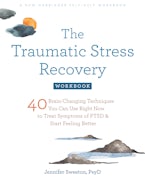By Jennifer Sweeton, PsyD, author of Traumatic Stress Recovery Workbook
Traumatic experiences frequently result in “one trial learning,” meaning that a single event, or experience, can alter brain structure and/or functioning, which in turn results in new learning that is quickly solidified. Though other types of learning usually require repetition, trauma learning can happen after just one experience.
This new learning, while usually very helpful for survival, can compromise mental health and long-term well-being. In particular, after trauma the brain may learn that it is unsafe to relax, that the world is (or people are) dangerous, and/or that constant vigilance is protective. For instance, if you experienced a home-invasion incident, your brain may “learn” that you are not safe in your own home, or that you are unsafe when you are alone, or that you need to constantly be on guard for intruders. The ability to learn these lessons, and quickly, demonstrates how powerful the brain can be!
During traumatic experiences, the “threat detection” center of the brain—the amygdala— activates, and this leads to a cascade of reactions that put the brain and body in the stress response. This “survival mode,” when activated, leads you to (unconsciously) select an instinctive survival strategy, which may include fighting, fleeing, or freezing. And these survival responses, all of which are associated with amygdala activation and stress, become credited with your survival—whether they actually helped or not. In other words, your brain learns that you survived the trauma, essentially, by becoming stressed and entering survival mode.
Given that the brain’s primary goal is to keep you alive (not mentally healthy!), it makes sense that the brain learns, very quickly, how to best do this when your life is threatened. Moving forward, after a traumatic event, the brain has learned that threats to your safety exist, and that the best way to keep you alive in the face of those threats is to keep you hyper-attuned to your surroundings at all times—even if that means you’re stressed out, anxious, and in survival mode all the time. The result is that you may find it difficult to exit survival mode, downregulate the amygdala, and just relax. To better understand how anxiety/hyperarousal occurs after trauma, here is a summary of what many people experience:
1. Trauma happens, and the amygdala activates. When you experience trauma, your amygdala, which is the area of your brain responsible for detecting threat and danger, activates. This activation alerts the rest of the brain and the body that a threat is present and something terrible is happening (or about to happen). This is what happened when Angela first realized someone was breaking into her home.
2. Your stress pathway activates. After the amygdala activates, it sends the threat signals to the hypothalamus, which then activates the “stress pathway” known as the HPA axis. The HPA axis is comprised of the hypothalamus, pituitary, and adrenals. When this pathway becomes activated, it initiates the stress response in the body.
3. Your body goes into the stress response. When the HPA axis activates, the body enters the stress response, which often leads to somatic reactions such as a racing heartbeat, shallow breathing, muscle tension, upset stomach, dizziness, and other symptoms. Angela may have experienced these, and other symptoms, as the trauma occurred.
4. The “thinking area” of the brain dulls. As the body moves into the stress response, the amygdala’s activation also dulls activation in the “thinking area” of the brain, the prefrontal cortex. The result is that it becomes difficult to focus, concentrate, or Feeling Anxious and Revved Up. It also can lead to difficulty remembering some pieces of the traumatic event.
5. The brain chooses a survival response. In an attempt to survive the threat the amygdala has detected, the brain will choose a survival response—fight, and prepare to address the threat head-on in some way; flee, and run away or escape the threat somehow; or freeze, and go numb and immobile in the face of something that seems or is too overwhelming to respond to otherwise. Angela reported that during the traumatic event she fled, running out the back door in an attempt to escape danger. Fleeing was the stress/survival response her brain chose.
6. You survive the trauma, and the brain remembers how. When the traumatic event is over and it becomes clear that you have survived, the brain makes note of this and quickly learns that the survival response (which occurred in the context of amygdala activation and extreme stress) worked. Fighting, fleeing, or freezing, and becoming extremely stressed, helped keep you alive. To ensure survival moving forward, the brain continues to produce the stress response, making you feel chronically anxious and hyperaroused. While this feels terrible, the brain has learned that the world can be a dangerous place and that survival responses can keep you alive, so the amygdala continues to activate, keeping you in “survival mode” just in case another threat comes along.
Jennifer Sweeton, PsyD, is a clinical and forensic psychologist, and an internationally recognized expert on trauma, post-traumatic stress disorder (PTSD) and the neuroscience of mental health. She is author of Trauma Treatment Toolbox.



 Part 2: What to Do When a Client Is Participating in Self-Judgment?
Part 2: What to Do When a Client Is Participating in Self-Judgment?